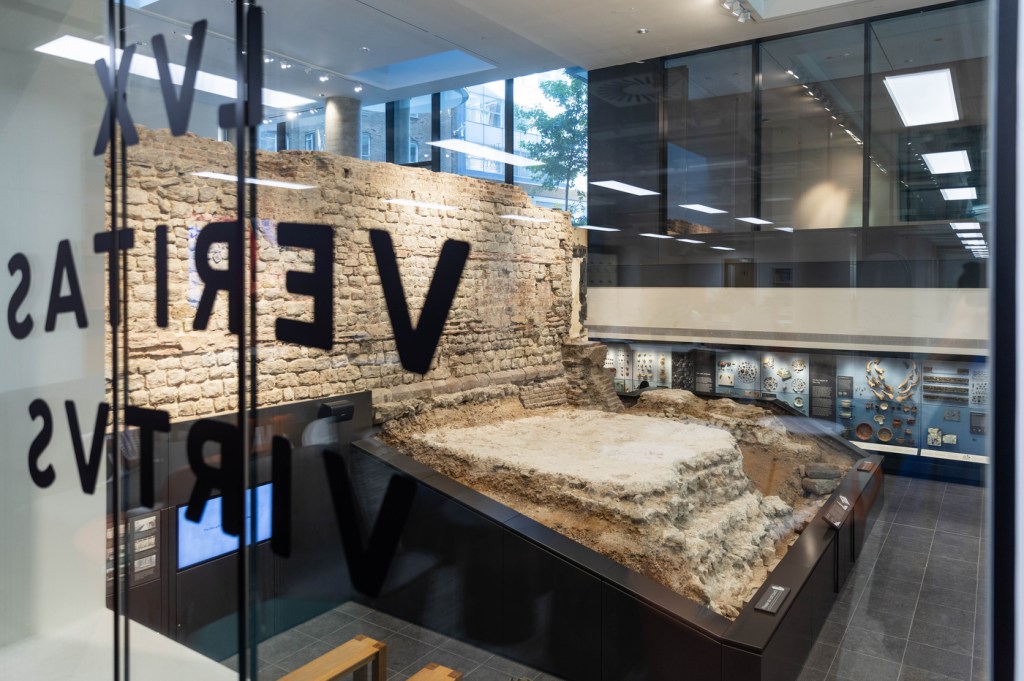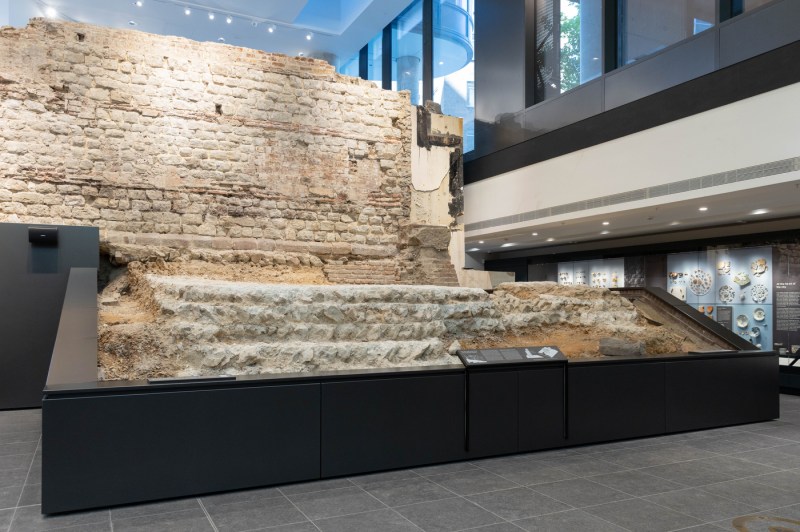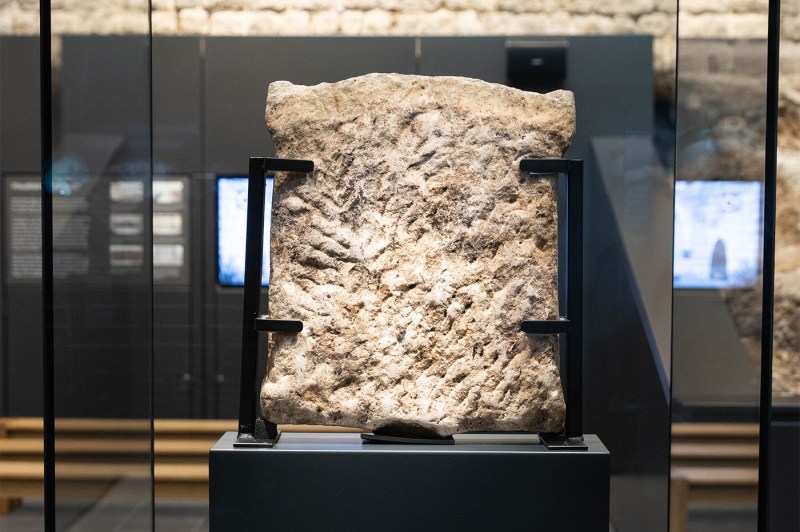Northeastern’s London startup hub has a section of Roman wall running through it. These experts explain how it got there
History faculty members Lars Kjaer and Michael Peplar explore what encouraged the Romans to build the wall and how it survived 1,800 years of turmoil.

LONDON — As entrepreneurs at Northeastern University’s startup hub look out as they sip a coffee, their view takes in 1,800 years of history.
Standing steadfast just meters from the Senzo City cafe attached to the hub is a slab of Roman wall that was once part of an impressive 2-mile structure that encased the entire city.
The section, now the focal point of a museum and event space called “The City Wall at Vine Street,” has survived the fall of the Roman Empire, the Black Death plague, the Great Fire of London and the World War II blitz. In fact, the monument is the only example left of a Roman bastion — a defensive tower — in the U.K. capital.
Northeastern associate professor Lars Kjaer, who teaches about the Roman Empire, and London history expert Michael Peplar explain the tribulations the wall has lived through to remain standing today in a building occupied by the university.
When the Romans first settled in Britain in 43 Common Era (CE), Kjaer says the city they called “Londinium” gradually prospered as a “nexus” for settlement and trade during a 150-year period of relative peace in northern Europe.
But by the third century, the empire had become more turbulent and, emulating what they had done with the 73-mile Hadrian’s Wall in northern England almost 80 years earlier, the Romans decided London needed fortifying.
“Britain and the Roman Empire as a whole was increasingly under pressure,” Kjaer says. “It was becoming a perilous place and the wall is testimony to that.
“They built a wall around London in around 200 CE. It was continuously expanded over the third century to cover all of the city on the northern bank of the Thames — what is now the City of London.”


It is not known exactly what prompted Emperor Septimius Severus’ legionnaires to build the structure, Kjaer says, but it is thought that attacks on Britain raised fears that London could face an incursion.
“There certainly were raids happening in Britain and they must have been worried because it is a huge inconvenience to build a wall,” says the medieval history expert. “It is really expensive and not very practical either — it is much easier to have a trading city with open access, so they must have been very seriously concerned about the threats out there.”
The empire eventually did collapse and Kjaer says that from the fifth century, post-Roman Britain fell into “apocalyptic catastrophe” with society collapsing into a “Mad Max” style situation following a breakdown in political administration, trade and taxation.
London was “abandoned” and “left in ruins” during this period, Kjaer explains. It remained like that for centuries until the Anglo-Saxons, who occupied Britain between 410-1066, eventually settled around the city in the eighth century, calling it “Lundenwic.” But they still did not inhabit inside the walls, instead setting up a territory around what today is The Strand, Kjaer adds.
It is only when Viking raids started to play havoc in the ninth century that the Anglo-Saxons deployed the wall for its original fortress purpose once again, Kjaer says, with King Alfred The Great using London as a “defensive bastion” against the Scandinavian invaders.
Kjaer says the wall went on to play a decisive role in the development of modern democracy as its strength helped lead to the signing of the Magna Carta — a formal document setting out that the king was subject to the law.
“In the war of 1215, one of the crucial moments that forced King John to recognize the demands of the barons, to accept Magna Carta and the limitations on the powers of the crown, is when London sided with the rebels,” Kjaer says. “Once they opened up their gates to the rebels, it was too much — the scales tipped and he had to seek a compromise.”
The wall would stand for centuries more, as a reminder of London’s “ancientness” harking back to the Roman era, Kjaer says. But Peplar, an associate professor of history who specializes in English popular cultural history, says large segments of the wall would eventually be knocked down as London expanded from the 18th century onward.
“It was a huge structure and the vast majority of it has gone — and that is not unusual in British walled cities,” he says. “Most cities with medieval walls did get rid of them. And the reason was that cities were growing, particularly in the 19th century. The British population was growing and London’s population was growing enormously.”
London went from having a population of around one million people in 1800 — on a scale comparable with global capitals like Tokyo and Istanbul at the time — to being the world’s largest city 100 years later, with a population of almost seven million.
“This is something that people had never had to deal with before,” says Peplar. “They are dealing with something that is new and everything that goes with that.”
The population exploded due to people moving from the countryside to work in urban industrialized industries. Peplar sets out how the Roman walls began to be seen as a “block to development” by city officials who wanted to improve sewage and transport infrastructure and rid London of its impoverished and squalid living conditions.
“It was about wanting to move away from a medieval street pattern to something wider and bigger and more able for people to be able to move goods around,” Peplar continues. “The Victorians would have seen the wall as limiting progress, transportation and communication. It was also seen as really old fashioned.”
Editor’s Picks
Parts of London’s wall would be demolished to make way for one of the great inventions of the 19th century — the railways and its train stations.
Archeology in the Victorian era, Peplar explains, would have been in its infancy, with less focus on preserving the past. It was not until 1905, according to English Heritage, that there is evidence of the wall being more consciously conserved. It would eventually be put under government guardianship and today is listed as a “Scheduled Monument,” denoting its national importance as an archaeological site.
Peplar notes that while only small chunks of the wall remain today dotted about, it is still in the fabric of London. The wall was repurposed throughout the centuries — The City Wall At Vine Street shows signs of having been added to — and was incorporated into developments as either foundations or new walls.
The wall also gave London its geography. Roads leading into the former walled areas are still largely the same, while the sites of gateways demolished long ago give their names to areas such as Bishopsgate and Aldgate.
Peplar describes how it is possible to walk the old Roman city even today. “If you go from Ludgate [near St. Paul’s Cathedral] over in the west to Aldgate, that is the whole span of the old city,” he says.
“You can see where the fortified area was and you can even trace some of it along the road. If you go along roads like Houndsditch and Jewry Street, there are odd shaped roads that are curved. If you walk around them, you are walking around what would have been the edge of the old walls.”











